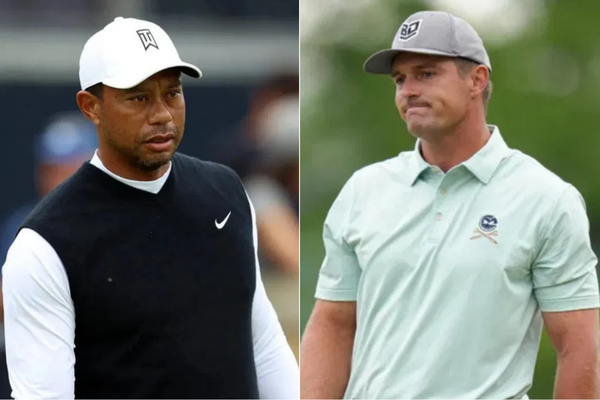
via Imago
Image Credits: IMAGO

via Imago
Image Credits: IMAGO
As a golf coach, having Tiger Woods on your resume is the ultimate credential. For three years since 2014, Woods and his newly hired coach worked closely, but their collaboration didn’t yield major successes. We are talking about Chris Como, a well-regarded instructor known for his knowledge in Kinesiology and Exercise Science. His background in biomechanics aimed to refine Woods’ technique, potentially reducing injury risks and improving consistency. A few believed the partnership concluded due to the overemphasis on technical aspects. So, in 2017, Woods announced he would continue working independently, expressing gratitude for Como’s contributions.
His coaching leans on feel, technique, and technology, customizing each swing for golfers. Don’t take this lightly. Como integrated technologies like TrackMan (ball flight and swing mechanics data curator) and 3D motion capture systems! While working with the greatest golfer of all time would satisfy most coaches’ career ambitions, Chris Como naturally found himself more intrigued by a physics-obsessed golfer with wild scientific theories. A perfect collaboration!
ADVERTISEMENT
Article continues below this ad
Como’s deep dive into Bryson DeChambeau’s game
The golf world naturally assumed that guiding the 15-time major champion would stand as Como’s career pinnacle. Yet in a recent appearance on The Smylie Show podcast, Como revealed a surprising truth. His five-year journey with Bryson DeChambeau ultimately became his most memorable coaching experience. “Spending time with Bryson was amazing,” Como shared candidly. “It was its own crazy kind of rabbit hole to go down with a person.”
Their partnership began conventionally enough in 2018. Como initially kept DeChambeau in his “personal sweet spot” as a player. This traditional approach yielded impressive results right away. DeChambeau captured multiple victories, including the Northern Trust and Dell Technologies Championship, during the FedEx Cup Playoffs. “I know he won Playoff events, I remember that like up in Caves Valley,” Como recalled specifically about their early work together. These victories helped establish DeChambeau as a top-tier talent even before their distance experiment began.
Then came the pandemic shutdown that changed everything. While most players worried about maintaining their games, DeChambeau saw an opportunity. “Man, I want to get more speed,” DeChambeau told his coach during the COVID break. This simple statement launched them into what Como described as “Meathead time.” The pair began reimagining what was physically possible in golf.

USA Today via Reuters
May 18, 2024; Louisville, Kentucky, USA; Bryson DeChambeau reacts after a putt on the first green during the third round of the PGA Championship golf tournament at Valhalla Golf Club. Mandatory Credit: Adam Cairns-USA TODAY Sports
Como immediately recognized DeChambeau’s unique potential for distance gains. “He was a really, really straight hitter of the golf ball,” Como explained on the podcast. This accuracy provided crucial wiggle room for their experiment. The golfer’s technical foundation, built with former coach Mike Schy, created the perfect platform for adding distance without sacrificing control.
The transformation went far beyond typical coach-player dynamics. During lockdown, Como built a complete biomechanics lab in his living room. He installed force plates and motion capture technology that had previously only been used in academic settings. Meanwhile, DeChambeau implemented his now-famous bulking regimen. The coach was learning as much as teaching throughout this scientific journey. But the real breakthrough happened when Como transformed their approach from instinctive to analytical, blending science with golf in unprecedented ways.
ADVERTISEMENT
Article continues below this ad
The data-driven distance experiment
Como’s approach became increasingly scientific and collaborative during this unusual period. He partnered with statistical expert Mark Broadie to develop predictive models about distance. “I created this graph with Chris Broadie showing a person’s strokes gained potential,” Como explained. The model precisely calculated how clubhead speed increases would affect scoring based on individual dispersion patterns.
Their data revealed a counterintuitive truth about modern golf. Players could sacrifice some accuracy for significant distance and still improve overall. “If you gain, let’s say three yards off the tee, you can be six more yards offline,” Como noted. This mathematical formula gave them confidence to pursue dramatic changes despite DeChambeau’s already successful career. Then, tech-Science faced its ultimate test at the 2020 US Open at Winged Foot. The notoriously difficult venue featured narrow fairways and unforgiving rough. Everyone advised caution. “I had so many people telling me he’s got to hit irons off the tee,” Como remembered. Their data suggested a bolder strategy would work better.
ADVERTISEMENT
Article continues below this ad
Como challenged conventional wisdom with their research-backed approach. “I called Mark Broadie with this hypothesis,” he explained. Their calculations showed that with such narrow fairways, bombing driver remained optimal even in US Open conditions. The controversial strategy worked brilliantly. DeChambeau overwhelmed Winged Foot with distance and captured his first major championship.
What started as a partnership evolved into a scientific journey that redefined modern golf strategy. Interestingly, Como has noted one striking similarity between his two most famous students. “They both are on that never-ending quest to get better,” Como once revealed. Probably the most educational experience of his coaching career. What do you think about Como’s revelation? Has DeChambeau’s distance-focused approach been good for golf? Let us know in the comments below!
ADVERTISEMENT
ADVERTISEMENT
ADVERTISEMENT
ADVERTISEMENT

